Bennemann K.H., Ketterson J.B. Superconductivity: Volume 1: Conventional and Unconventional Superconductors; Volume 2: Novel Superconductors
Подождите немного. Документ загружается.

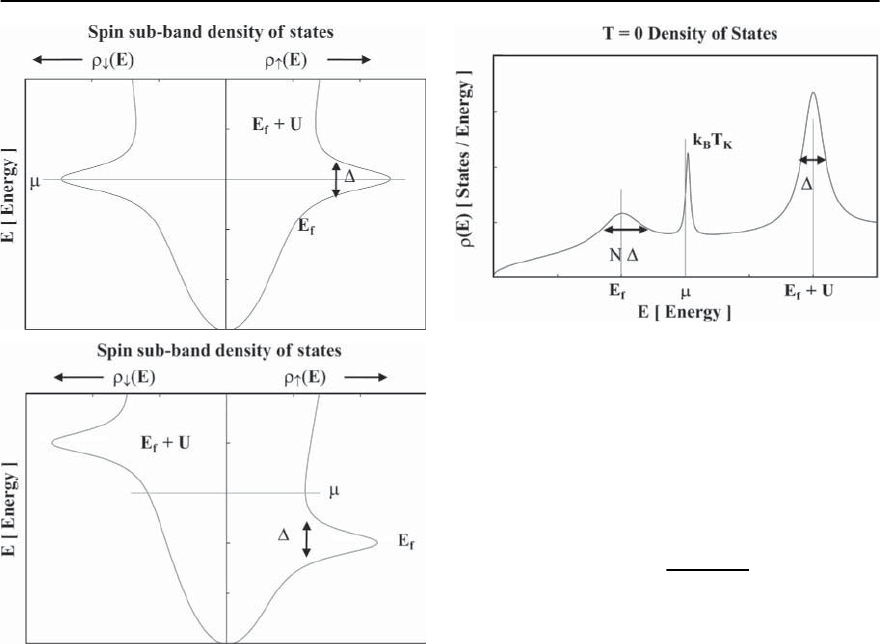
1070 P.S. Riseborough,G.M. Schmiedeshoff,and J.L.Smith
Fig. 19.27. The density of states of the single-impurity An-
derson model, as calculated in the Hartree–Fock approxi-
mation.The density of states is composed of the sum of the
conduction band contribution and a contribution from the
f state on the impurity. In the mixed valent limit, shown
in upper figure,the virtual bound state is unpolarized.The
virtual bound state is located at the energy E
f
+ Un
f
/2.
In the Kondo limit where the local moment is present, the
virtual bound state is spin split, as shown in lower figure.
[After Anderson [160]]
store the broken symmetry. These residual interac-
tions were investigated by Schrieffer and Wolf [161],
who mapped the local moment limit of the single-
impurity Anderson model onto the single-impurity
Kondo model. In the single-impurity Kondo model
[162], the repeated spin-flip scattering between the
local moment and the conduction electrons results in
theformation of a singlet bound state.Theproperties
of the Kondo model show scaling with the energy of
theboundstatewhichisk
B
T
K
. The Kondo tempera-
Fig. 19.28.Aschematicplot oftheT = 0 density of states for
theN–fold degenerate single-impurity Anderson model, in
the Kondo limit.The f contributionto the density of states
has features at energies of E
f
and E
f
+U.Inaddition,atlow
temperatures,a narrow Kondo resonance of width k
B
T
K
/N
occurs at an energy k
B
T
K
above the Fermi energy
ture for a spin one-half impurity is estimated to be
of the order of
k
B
T
K
∼ ()
−1
exp
(E
f
− )
2
, (19.125)
where E
f
is the energy of a single electron in the f
state of the isolated impurity. Due to the presence of
the exponential factor, the Kondo temperature is ex-
pected to be much smaller than . For temperatures
above T
K
, the bound state is thermally depopulated,
and the high temperature properties may be ade-
quately described by low order perturbation expan-
sions [163].However,asthe temperature is decreased
below the Kondo temperature, the resonant nature
of the scattering increases and weak-coupling per-
turbation approximation fails,since the model scales
to a strong-coupling fixed point [164,165]. Near this
fixed point, the properties scale with T/T
K
and are
qualitatively described by a gas of non-interacting
quasi-particles residing in a narrow virtual bound
state of width k
B
T
K
located near the Fermi energy
(see Fig. 19.28). The exact Bethe–Ansatz solution
[166–168] of the model shows that the low temper-
ature properties are those of a local Fermi liquid.
In the local Fermi liquid, the low temperature sus-
ceptibility is enhanced relative to the linear T coef-
ficient of the specific heat by a factor that depends

19 Heavy-Fermion Superconductivity 1071
on the degeneracy, N, of the ground state magnetic
configuration.For large degeneracies,the relative en-
hancement or Wilson ratio is simply N/(N −1).Al-
though the Wilson ratio and the scaling property of
the Kondo impurity model are in reasonable agree-
ment with experimental results on dilute Ce systems,
Nozi`eres has questioned whether the results of the
simple Kondo model can be directly applied to con-
centrated Ce compounds [169]. In particular, in the
Kondo model the screening of a local moment only
involveselectrons within k
B
T
K
of theFermi-level.For
a concentrated compound in which the moments on
each f ion are screened by a number of conduction
electrons localized around each of them, the number
of conduction electrons required for screening is far
greater than the number k
B
T
K
() allowedfor by the
solution of the single impurity model.If instead,one
assumes that the screening electrons remain itiner-
ant and only form a resonance instead of a bound
state, the spinflip interaction of the conduction elec-
trons with the local moments may still produce a
non-magnetic state in which the local moments are
slowly fluctuating. That is, Nozi`eres argument does
not apply if the conduction electrons responsible for
the screening remain itinerant [170].In thiscase,one
must abandon the purely local description at suffi-
ciently low temperatures.
It is more likely that the Kondo paradigm con-
tains the generic physics of local electronic cor-
relations observed in the heavy-fermion materi-
als. This has lent credence by the recent discovery,
based on the infinitedimensional limit d →∞,that
strongly correlated metals can have physical proper-
ties which qualitatively resemble those of localized
magnetic impurities [171–173]. The limit d →∞
of most many-body models is usually exactly sol-
uble via mean-field theory and can be scaled such
that it can be exactly mapped onto a non-trivial
effective local impurity model. In the resulting dy-
namical mean-field theory, the local fluctuations on
the neighboring lattice sites are treated as being
governed by an effective single-impurity Anderson
model in which the hybridization to the conduction
electron density of states has to be determined self-
consistently [174,175]. This theoretical approach is
more promising than that of the single impurity
Kondo model, as it decouples the temperature scale
of the resonant magnetic scattering in the high tem-
perature regime, and the temperature scale below
which the low temperature Fermi liquid forms [176].
In addition to the questions posed by Nozi`eres, it is
quite unclear how the U compounds could be di-
rectly described by simple Kondo impurity models
in which the 5f states are assigned as belonging to a
uniquemagnetic configurations.It seems morelikely
that the U systems may be described by more gen-
eral many-bodymodels such asmulti-bandHubbard
models, which may also be described by dynamical
mean-field theory. The application of dynamical
mean-field theory to heavy-fermion systems is lim-
ited by its failure to describe non-local correlations.
As dynamical mean-field theory omits the effect of
non-local spin-fluctuations,and as quantum critical
points occur when the non-local magnetic correla-
tions dominate over the local spin-fluctuations [90],
dynamical mean-field theory is expected to be inad-
equate close to quantum critical points.
For some heavy-fermion compounds, the charac-
teristic temperatures T
K
inferred from thermody-
namic, transport, magnetic and other spectroscopic
probes, are quite consistent. However, even for these
systems, the low temperature thermodynamic prop-
erties do show the existence of other low-energy
scales that are often attributed either to Fermi liq-
uid formation or the onset of spatial coherence or
spatial magnetic correlations. In the quantum criti-
cal point description, this coherence temperature is
identified as the cross-over temperature at which the
physics of the quantumcritical point gives way to the
physics of the Fermi liquid fixed point [177,178].In
a phase space that is extended, as for instance when
pressure is applied, the line of cross-over points is
experimentally accessible since physical quantities
should exhibit extrema on parallel lines. The phe-
nomenon of coherence is most clearly manifested in
transport phenomena, though it does also show up
directly in high resolution spectroscopic measure-
ments on single crystals [179]. The phenomenon of
coherence falls beyond the scope of the exactly sol-
uble single-impurity Kondo models or dynamical
mean-field theory and, therefore, still lacks an ad-
equate theoretical description.
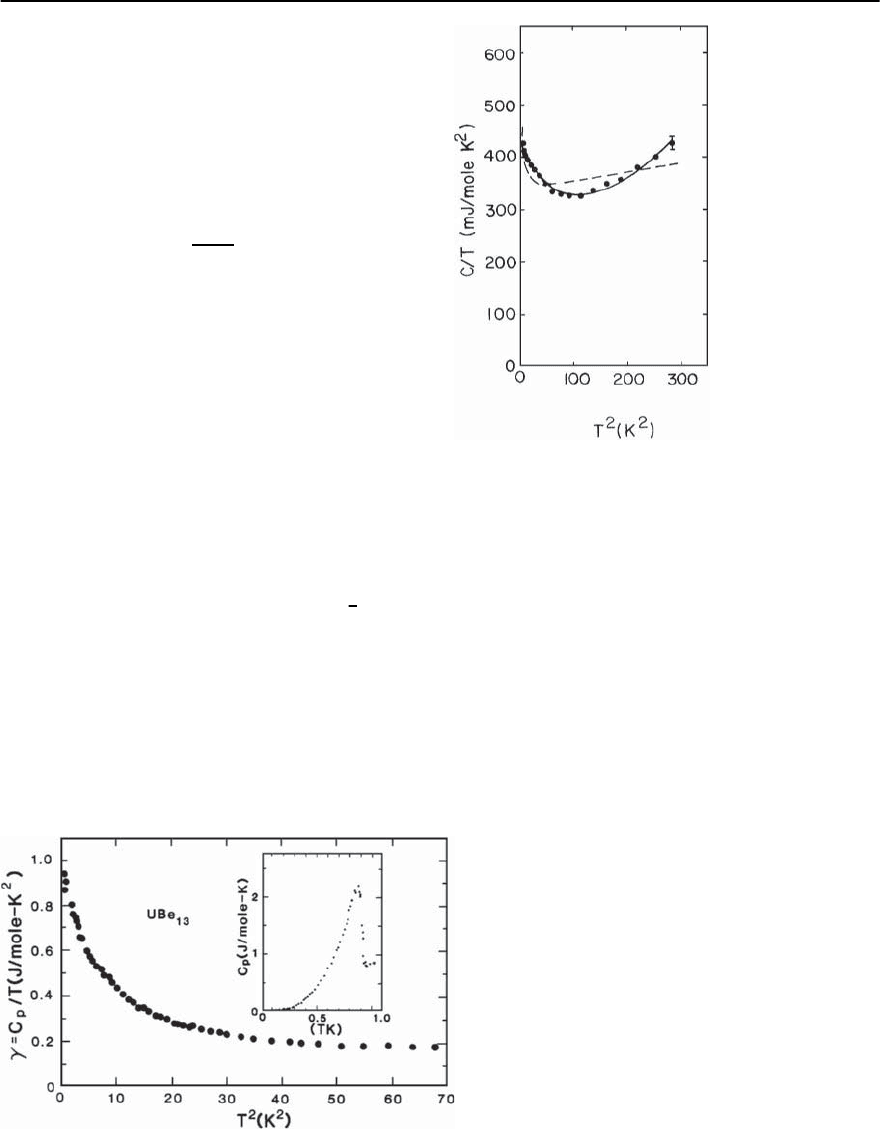
1072 P.S. Riseborough,G.M. Schmiedeshoff,and J.L.Smith
19.3.1 Thermodynamic Properties
The Specific Heat
The low temperature specific heats of the normal
state phase of heavy-fermion systems are dramati-
cally different from ordinary metals. The extrapo-
lated value of the ratio of the specific heat to the
temperature
lim
T→0
C(T)
T
= (19.126)
can be of the order of 1 J/mole K
2
,whichis 1000 times
larger than the corresponding ratio for Cu. In many
heavy-fermion systems, notably UBe
13
,CeCu
2
Si
2
,
CeAl
3
and CeCu
6
,theratioC(T)/T shows an increase
with decreasing temperatures, at low temperatures,
and shows signs of saturation. For UBe
13
and CeAl
3
the upturn starts at a scale of the order of 10 K. The
heat capacity of UBe
13
is shown in Fig. 19.29. The
large magnitudes of the extrapolated specific heat
coefficients are attributed in part to the flat quasi-
particle dispersion relation arising from the small
hybridization between the f orbitals and the states
on the ligand atoms and in part due to the average
of the quasi-particle mass enhancement, Z
k
.Theas-
signment of the large value of the coefficient as
being due to enhanced quasi-particles is found to be
consistent with de Haas–van Alphen measurements.
For UPt
3
and UAl
2
, the specific heat has the form
C(T)= T + ıT
3
ln T + ˇ T
3
(19.127)
for temperatures up to 20 K. The low temperature
specific heat of UPt
3
and the fit to this form are
Fig. 19.30. The low temperature specific-heat ratio C(T)/T
versus T
2
for UPt
3
.Thesolid line is a fit to C(T)=
T + ıT
3
ln T.Thedashed line is a fit to T + ˇT
3
+ ı/T.
[After Stewart et al. [6]]
shown in Fig. 19.30. The above form and the sign
of ı arecompatiblewithaFermiliquidthatex-
hibits large amplitude, long wavelength, collective
fluctuationssuch as ferromagnetic spin-fluctuations
[90,91, 97, 98]. The values of the coefficients ˇ are
also quite large compared with values expected from
phonon contributions in normal metals and prob-
ably could also have a significant electronic compo-
nent.Theentropies calculatedfrom the enhanced low
temperature specific heats have values comparable
Fig. 19.29. The specific heat in the normal state of UBe
13
divided by temperature as a function of T
2
. [After Ott
et al. [4]]. Note the upturn at low temperatures and the
large extrapolated value at T = 0 as compared to the
value of 0.07 mJ/mole/K
2
for Cu
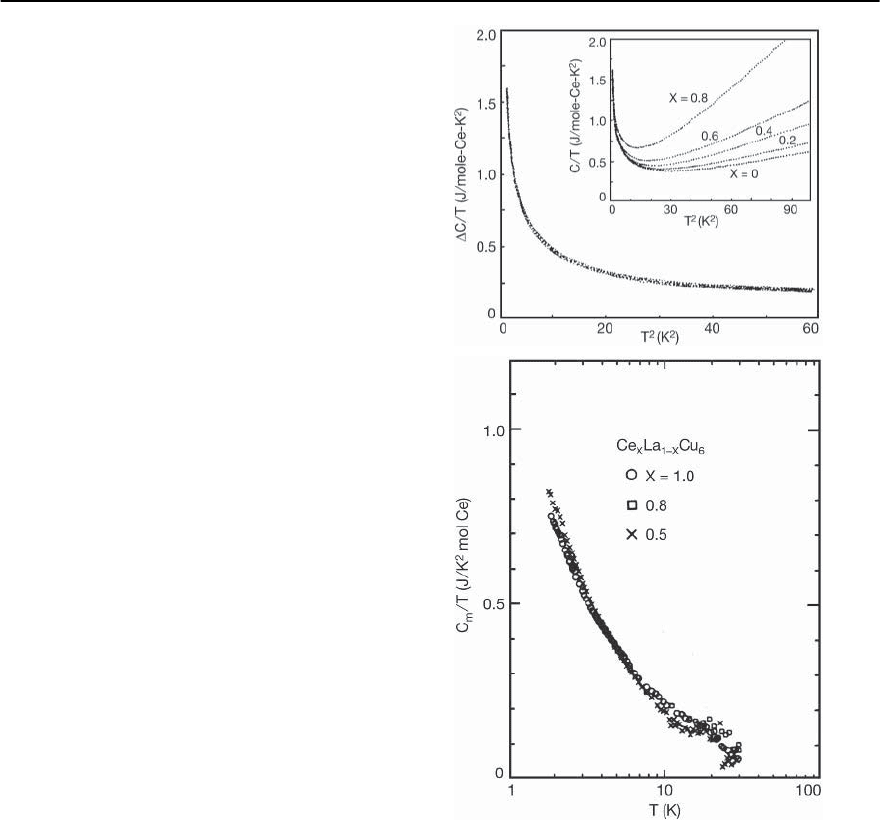
19 Heavy-Fermion Superconductivity 1073
to those of a disordered set of independent moments
on the f ions,suggesting a magnetic origin of the en-
hancement.This conclusion is strengthened for UAl
2
by the finding [180,181] that an applied magnetic
field actually suppresses the low temperature upturn
in C/T.
An unusual feature of the specific heat of some
heavy-fermion systems is that they seem to indicate
that the fluctuations are of a local character and re-
side mainly on the f ions. For example, on substi-
tuting La for Ce in CeCu
6
, the temperature depen-
dence of the specific heat of Ce
x
La
1−x
Cu
6
per Ce ion
is independent of x, for 1 > x > 0.5, indicating
that the large specific heat of this Ce compound is
dominated by local processes [182]. A similar con-
clusion was previously drawn from dilution studies
of CePb
3
[183], where it was found that the proper-
ties simply scale with the Ce concentration. The spe-
cific heats per mole Ce of diluted CePb
3
and CeCu
6
are shown in Fig. 19.31. This type of scaling behav-
ior should be contrasted with the behavior found
in dilution studies of CeCu
2
Si
2
,CeAl
3
and UBe
13
.In
stoichiometric CeAl
3
,theC/T ratio shows a small
maximum around T =0.3 K [184], and on doping
substitutionally for Ce with La, the peak moves up to
higher temperatures. However, the Kondo tempera-
ture decreases with doping [185].Calculations based
on single impurity models show that the low temper-
ature peak is not simply due to the Kondo effect in
the presence of crystal fields [186,187].Therefore, it
has been speculated that the peak is either due to the
onset of magnetic correlations or is a manifestation
of structure in the quasi-particle density of states
caused by the coherence of the lattice.
There exists a similar low temperature peak in the
specific heat of UBe
13
near T = 2K which is sup-
pressed and moves towards lower temperature on
substituting 3 percent of U by Th [188]. Substitu-
tional doping on the U sites of UBe
13
by a few per-
cent of impurities leads to a rapid decrease in the
value.The introduction of roughly 3% concentration
of impurities leads to a depression of by roughly
30 %. These studies suggest that the value of cru-
cially depends on the U–Be separation. Stoichiomet-
ricCeCu
2
Si
2
seems to be on the criticalphase bound-
ary between a phase that exhibits magnetic correla-
Fig. 19.31. The low temperature specific-heat ratio C(T)/T
versus T
2
for UPt
3
.Thesolid line is a fit to C(T)=
T + ıT
3
ln T.Thedashed line is a fit to T + ˇT
3
+ ı/T.
[After Stewart et al. [6]]
tions at low temperatures, the A phase and a phase
that superconducts at low temperatures, the S phase.
A generalized phase diagram of CeCu
2
Si
2
is shown
in Fig. 19.32. The A and S phases seem to coexist in
stoichiometric single crystals [189]. In this case, al-
tering the composition can result in the stabilization
of the separate phases [190,191].The A phase shows
a specific heat due to heavy quasi-particles perhaps
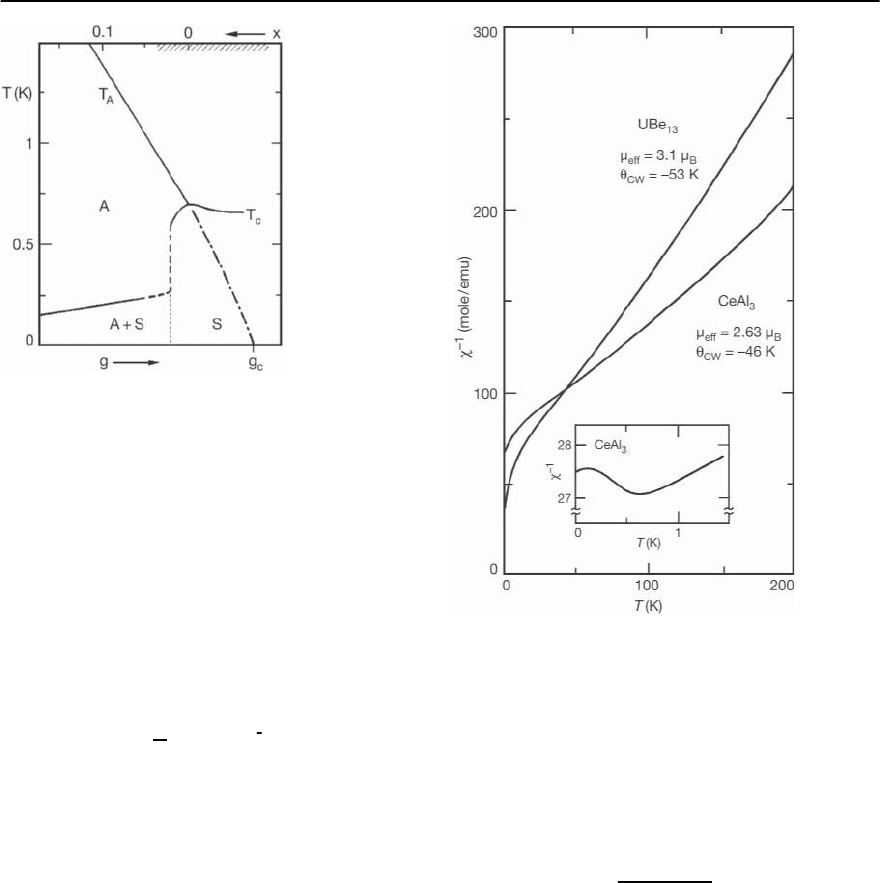
1074 P.S. Riseborough,G.M. Schmiedeshoff,and J.L.Smith
Fig. 19.32. A schematic phase diagram for CeCu
2
Si
2
at zero
field, indicating the existence ranges for a spin density
wave-like phase (A), superconductivity (S), and the coex-
istence ranges (A + S). The abscissa is an effective coupling
constant g which is proportional to x in CeCu
2
(Si
1−x
Ge
x
)
2
or to the composition in homogeneous CeCu
2
Si
2
.[After
Gegenwart et al. [193]]
including a T
3
ln T contribution arising from ferro-
magnetic spin-fluctuations [192]. In the presence of
applied magnetic fields sufficiently large to suppress
the superconductivity, the S phase appears and has
a non-Fermi-liquid like temperature dependence of
the specific heat [193]
C
T
=
0
− AT
1
2
. (19.128)
This non-analytic temperature variation indicates
that the material is either close to a quantum critical
point in which non-local correlationsare developing,
or that there is a significant amount of local disorder
as has been inferred from neutron measurements of
the nuclear pair distribution function [194].
The Magnetic Susceptibility
The magnetic susceptibilities of heavy-fermion sys-
tems show temperature driven cross-overs between
forms reminiscent of local moments and low tem-
perature Pauli-likesusceptibilities.This is illustrated
in Fig. 19.33, which shows the temperature depen-
dence of the susceptibilities for UBe
13
and CeAl
3
.At
Fig. 19.33. The temperature dependence of the magnetic
susceptibility (T)forUBe
13
and CeAl
3
plotted as
−1
(T).
The effective moments and Curie–Weiss temperature ob-
tained from high temperature fits are also shown. At low
temperatures, the temperature variation of (T)forCeAl
3
weakens and becomes Pauli-paramagnetic,as shown in the
inset
high temperatures, the susceptibilities can be fit by
the form
(T)=n
2
eff
3k
B
(T − Ÿ)
, (19.129)
where
eff
is the size of the effective magnetic mo-
ment, n is the density of local moments, and Ÿ is
the Curie–Weiss temperature. The values of the ef-
fective moment
eff
are nearly that of the free ionic
moments, and the values of the Curie–Weiss temper-
ature Ÿ are usually negative, suggesting antiferro-
magnetic interactions between the local moments.
At lower temperatures, the susceptibilities cross-
over to Pauli-paramagnetic susceptibilities that show
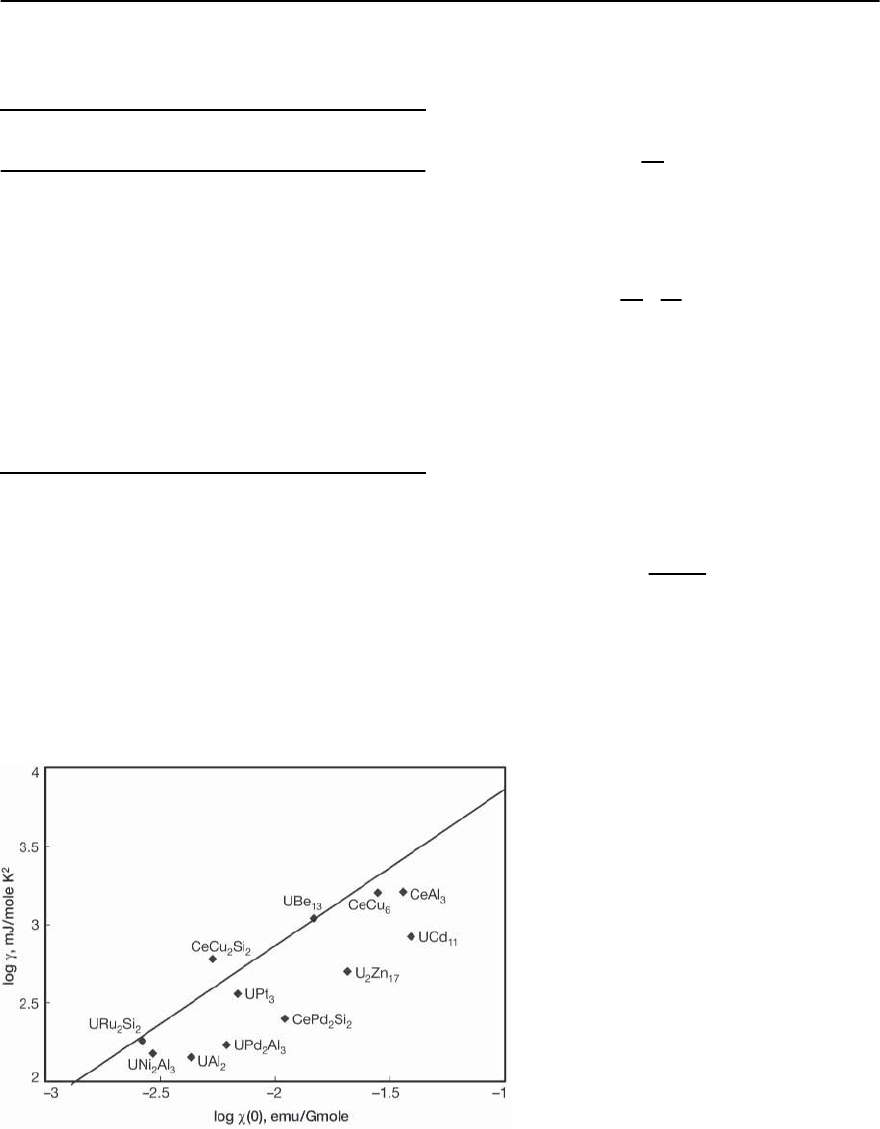
19 Heavy-Fermion Superconductivity 1075
Table 19.8. High Temperature properties of the normal
state. Anisotropic properties of crystals are given along
the principal directions in the form of “a/b/c”.
Material Ÿ
eff
(T = 300 K)
(K) (
B
)(§ cm)
UCu
5
284 3.52 286
UAl
2
245 3.1 190
UPt
3
50 / 170 2.5 / 2.37 230 / 135
U
2
Zn
17
105 3.3 110
URu
2
Si
2
65 3.51 324 / 169
UBe
13
53 3.1 107
UPd
2
Al
3
47 3.2 140 / 200
UCd
11
23 3.45 80
UGe
2
–34 2.7 156
CeCu
2
Si
2
140 2.68 90
CeCu
6
59 / 59 / 8 2.6 / 2.67 / 2.46 70
CeAl
3
46 2.63 65
large enhancements similar to those of the specific
heat coefficients.The cross-over from Curie–Weiss
like to Pauli-paramagnetic like susceptibilitiesseems
to occur at higher temperatures than the tempera-
tures at which the C/T ratios build up [195,196].
The magnitudes of the measured and (0) can
be compared indirectly by using the model of non-
interacting electrons. For the gas of non-interacting
electrons, the Pauli-susceptibility is given by
(0) = 2
2
B
() , (19.130)
where () is the density of states, per spin, at the
Fermi energy, and the specific heat coefficient is
given by
=2
2
3
k
2
B
() . (19.131)
Therefore, a plot of versus (0) for hypotheti-
cal non-interacting electron systems should yield a
straight line with slope given by
2
3
k
B
B
2
. (19.132)
As shown by Fisk et al. [197] (see Fig. 19.34), the
heavy-fermion systems have and (0) values that
lie close to the same line. Therefore, as the Wilson
ratio is close to unity,thisindicates that the enhance-
ments of thesusceptibilities have similar magnitudes
to the specific heat enhancements. From a Fermi liq-
uid point of view,one would expect that the uniform
static susceptibility should show an enhancement, S,
given by
S =
m
∗
/m
b
1+F
a
0
, (19.133)
where F
a
0
is the spin antisymmetric interaction be-
tween a pair of quasi-particles with angular momen-
tum l = 0. However,the specific heat is just enhanced
by the factor
m
∗
/m
b
. (19.134)
Fig. 19.34. A log–log plot of the limiting values,
per mole f material,of C/T in mJ/mole K
2
and
inemu/Gmole forselected heavy-fermion com-
pounds. The straight line represents the rela-
tion for non-interacting electrons. [After Fisk
et al. [197]]
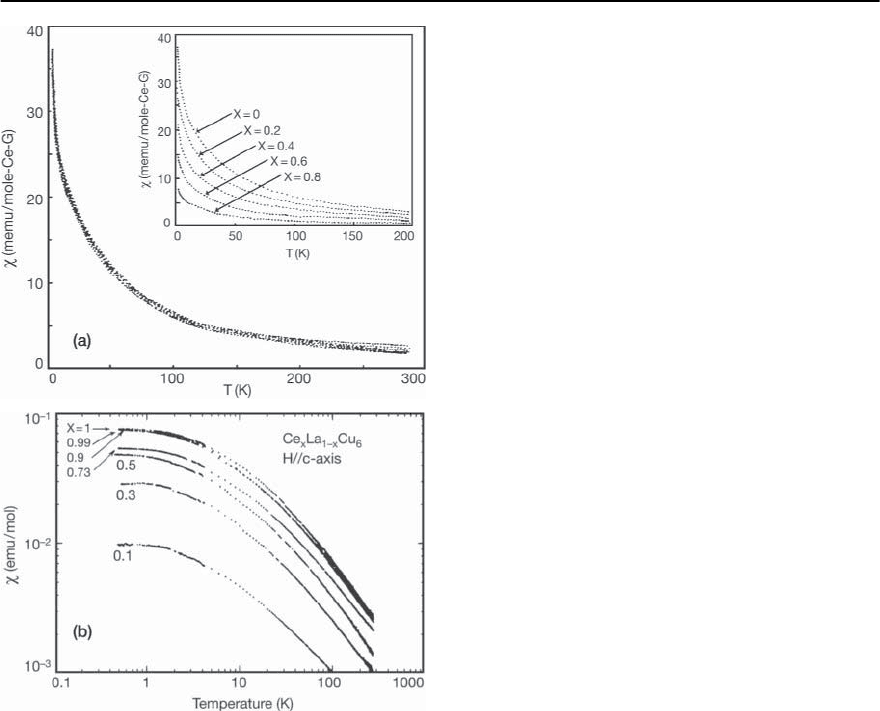
1076 P.S. Riseborough,G.M. Schmiedeshoff,and J.L.Smith
Fig. 19.35. (a) The magnetic susceptibility per mole Ce,
(T)versusT for Ce
1−x
La
x
Pb
3
samples with x =0.0, 0.2,
0.4, 0.6 and 0.8. Inset: The total susceptibility per molar
formula unit for the same samples. [After Lin et al. [183]].
(b) The magnetic susceptibility per mole formula unit for
Ce
x
La
1−x
Cu
6
, plotted versus T. [After
˜
Onuki and Komat-
subara [182]]
Thus, the to ratio yields information about
the spin-dependent interaction between the quasi-
particles. In most Ce compounds, both enhance-
ments seem to be due to single-site processes.
This can be seen by inspection of the susceptibil-
ity of Ce
x
La
1−x
Cu
6
per Ce ion, which is indepen-
dent of x in the range 1 > x > 0.1. The susceptibil-
ities of Ce
x
La
1−x
Cu
6
and Ce
x
La
1−x
Pb
3
are shown in
Fig. 19.35. The similarity of the curves suggests that
the large susceptibility, like the large specific heat, is
dominated by local processes involving the f elec-
trons. Since the spin-orbit split ground state of the
Ce
3+
ion corresponds to J =5/2 and degeneracy of
6, the ratio of the susceptibility to term predicted
by the single-site Kondo model should be very simi-
lar to the ratio for non-interacting electrons. On the
other hand, in UBe
13
doped substitutionally on the
U sites [198], the susceptibility seems to scale lin-
early with the number of U atoms, while the coeffi-
cient per U atom is rapidly reduced by dilution. This
suggests that an appreciable fraction of the mass en-
hancement in UBe
13
is not due to a single-site mag-
netic Kondo process. A similar conclusion has been
drawn from dilution studies of UPt
3
[199], which
show that dilution can result in the suppression of
the specific heat by up to 50% of the stoichiometric
value while the uniform static susceptibilityis barely
affected. These conclusions are consistent with mea-
surements of the de Haas–vanAlphen oscillations on
a number of U and Ce compounds, which show that
the quasi-particles are itinerant and form part of the
Fermi surface, albeit with a very small dispersion of
the bands.
de Haas–van Alphen Oscillations
Measurements of the magnetization in high fields
and at low temperatures show oscillations as a func-
tion of the inverse field. The presence of the oscil-
lations has long been held as an indicator that the
quasi-particles are itinerant, form part of the Fermi
surface, and are long lived. The oscillations are due
to the existence of Landau peaks in the density of
states, which are a consequence of the quantized or-
bital motion of the quasi-particles in the presence
of an applied field. As the applied field is increased,
the energy separation between consecutive Landau
peaks increases linearly with the field, and the os-
cillations occur as the peaks in the density of states
move through the Fermi energy. The fundamental
periods of the oscillations are related to the extremal
cross-sectional areas of the Fermi surface perpen-
dicular to the applied field. For non-interacting elec-
trons, the fundamental oscillation stemming from
each electron orbit around an extremal area is gov-
erned by the Lifschitz–Kosevich formula

19 Heavy-Fermion Superconductivity 1077
M
z
= A cos
cS
eH
z
+
, (19.135)
where S is the extremal area of k
space enclosed by
the quasi-particle orbitingaround the Fermi surface,
and is a phase reflecting the Zeeman splitting be-
tween the bands of different spins. The amplitude of
the oscillations, A,isgivenby
A ∼ V
k
B
TS
2
2
7
e
cH
z
(19.136)
× exp
−
2
2
m
b
c
eH
z
cosech
2
2
m
b
ck
B
T
eH
z
,
where is the lifetime due to scattering processes and
m
b
is the effective mass deduced from the dispersion
relation of the non-interacting electrons at the Fermi
surface.The scattering rate,1/,is usually introduced
in an ad hoc manner.The contributionfrom each ex-
tremal area contributes to the signal with the weight
given by
2
|
∂
2
S
∂k
2
z
|
, (19.137)
where k
z
is the component of the wave-vector par-
allel to the field. This factor expresses the weight of
an extremal cross-section relative to that of an ex-
tremal section of a spherical Fermi surface of the
same size, S. Since Fermi surfaces are often multi-
sheeted, the measured areas are typically compared
with the results of electronic structure calculations.
For most simple metals, the experimentally deter-
mined areas are usually in excellent agreement with
the LDA calculations.Since the oscillations originate
from the Landau peaks in the density of states pass-
ing through the Fermi energy, broadening, either due
to the Fermi function or from the effect of impurity
scattering on the Landau peaks, is expected to wash
out the oscillations. Therefore, one expects that the
oscillations should only be measurable at extremely
low temperatures (T < 1K), for high fields, and for
very high quality samples having very low residual
resistivities.
The Lifschitz–Kosevich formula must be modified
when the effect of electron–electron interactions are
introduced. First, the spin-splitting phase factor
may be exchange enhanced and may become field-
dependent [200].Phenomenologically,oneis also led
to expect that the scattering rate should be identified
with the imaginary part of the self-energy evaluated
on the Fermi surface and that the real part of the
self-energy may also be expected to appear as an ad-
dition to the imaginary part. In the thermal average
which is performed by transforming to a sum over
Matsubara frequencies !
n
, the real part of the self-
energy contains a term proportional to (1 − Z(0))!
n
,
and therefore, produces a correction of order k
B
T.
In the small H/T limit, the additional term origi-
nating from the real part of the self-energy can be
combined with the k
B
T dependence in the argument
of the cosech term in the non-interacting formulae,
thereby replacing the band mass m
b
by the quasi-
particle mass m
∗
. Thus,the temperature dependence
of the amplitude of the oscillations can beused to de-
duce the quasi-particle effectivemasses.As the linear
T term in the specific heat-capacity is related to the
average of the quasi-particle masses on the Fermi
surface, one may be able to compare the average of
the quasi-particle masses observed in de Haas–van
Alphen experiments with the specific heat. However,
in attempting to make this comparison, it is impor-
tant to note that some portions of the Fermi sur-
face may not have been observed in the de Haas–van
Alphen experiments. As can seen from Eq. (19.136),
the amplitudes of the heavier branches are expected
to be quite small and may easily be missed. Also, in
the case where the coefficientdepends on the mag-
nitude of the applied field, as it should if the quasi-
particle mass enhancements are of magnetic origin,
the average quasi-particle mass should be compared
with the specific heat measured under comparable
fields. It should be noted that the amplitude factor
contains the ratio of the quasi-particle mass to the
quasi-particle lifetime so, if the mass enhancements
arise from a local process, the quasi-particle mass
enhancement factor should cancel with the enhance-
ment of the quasi-particle lifetime. This cancelation
occurs much in the same way as the cancelation of
the enhancements in the residual resistivity(0) that
occurs when the self-energy is k independent. This
implies that the impurity scattering should not be

1078 P.S. Riseborough,G.M. Schmiedeshoff,and J.L.Smith
significantly more effective in reducing the ampli-
tude of the oscillations than in metals with compa-
rable density of states.
The de Haas–van Alphen oscillations were ob-
served in measurements on CeCu
6
,CeCu
2
Si
2
,UCd
11
,
UPt
3
,UPd
2
Al
3
,URu
2
Si
2
and CeRu
2
Si
2
for tempera-
tures between 200 and 100 mK and fields up to 18
T. Despite many valiant attempts, measurements on
UBe
13
have failed to yield de Haas van–Alphen os-
cillations [201]. In most of these materials, sheets of
the Fermi surface with large effective masses have
been found. The extremal areas inferred for UPt
3
are in good agreement with the Fermi surface ge-
ometry found from electronic structure calculations
[202, 203]. The effective masses inferred from the
amplitude can be factors of 10 to 30 times larger
than those found in LDA band structure calculations
[204,205], and the heavy masses found range from
25m
e
to 200m
e
. This suggests that the quasi-particle
mass enhancements due to electron–electron inter-
actions, are extremely large. The Fermi surface av-
erage of the observed effective masses produces a
quasi-particle density of statesthat is in rough agree-
ment with the value of UPt
3
. Whereas in UPt
3
the
quasi-particles at the Fermi surface have large ef-
fective masses, the effective masses found in CeCu
6
are smaller [208] and are in the range of 6 to 80 m
e
.
However, as the specific heat of CeCu
6
is appreciably
larger than that of UPt
3
, one suspects that the bands
with heavier masses were not observed. This situa-
tion also seems to be definitely the case for CeCu
2
Si
2
in which only small masses of 4 to 6 m
e
have been
observed [206]. The observation of the heavy mass
sheets of the Fermi surface in UPt
3
,butnotinCeCu
6
and CeCu
2
Si
2
, is probably due to the higher quality
of the UPt
3
samples. Also, part of the discrepancy
between the de Haas–van Alphen effective masses
and the specific heat of CeCu
6
measured in zero
field [207,208] is accounted for, if the field depen-
denceof thespecificheatis considered[209,210].The
decrease of the effective mass with applied magnetic
field is taken as anindicationthat spinflipexcitations
are responsible for partof themass renormalizations,
and that application of the field quenches the spinflip
scattering processes. The lack of agreement between
the specific heat and de Haas–van Alphen effective
masses in URu
2
Si
2
is very notable in that the only
effective masses that have been found, so far, are in
the range of 15 to 25 m
e
, and these only yield about
16 percent of the total value [211,212]. Likewise
for UCd
11
[213], the only effective masses observed
are only in the range of 2 to 11 m
e
. As previously
mentioned, the difficulty of observing heavy quasi-
particle mass branches of the Fermi surface is due to
the exponentially small amplitudes of their oscilla-
tions. However, both light and heavy quasi-particle
masses can be found in the same compound such as
in CeRu
2
Si
2
, where the observed masses are in the
range of 1 to 120 m
e
[214].
Some heavy-fermion materials undergo meta-
magnetic like transitions at high fields in which the
magnetizations undergo rapid change with respect
to magnetic field at a critical value of the field H
m
.
The meta-magnetic transitions become sharper at
lower temperatures. These highly non-linear suscep-
tibilities indicate either that the systems are on the
verge of undergoing an instability to a magneti-
cally ordered phase
7
or that a spin-split branch of
quasi-particles crosses the Fermi surface. For exam-
ple, URu
2
Si
2
may undergo as many as three tran-
7
For a paramagnetic system close to a magnetic instability, one expects that the free-energy expressed as a function
of the magnetization M could have a local minimum at M = 0, in addition to the global minimum at M =0.The
application of a magnetic field may cause the energy of the local minimum to be lowered, thereby stabilizing it at the
critical field H
m
associated with the meta-magnetic transition. The criterion for the occurrence of a meta-magnetic
transition can be easily calculated for the Stoner model. In the Stoner model,the magnetization-field relation is given
by
M =2
2
B
HS()
1+
1
6
−3
2
2
B
H
2
S
3
+ ...
, (19.138)
where S =(1−U ())
−1
is the Stoner enhancement factor. The terms non-linear in H can be large due to the appear-
ance of extra powers of S.The cubic term may be negative either if the density of states at the Fermi energy is close to a
maximum or if it is rapidly varying. If non-linear terms in M are negative, then meta-magnetic transitions may occur
at critical fields. Thus, meta-magnetic transitions may be expected to occur in the vicinity of quantum critical points.

19 Heavy-Fermion Superconductivity 1079
Table 19.9.Low temperature normal state properties (extrapolated to T =0)
Material (0) A (0)
(mJ mole f ion
−1
K
−2
)(10
−3
emu/mole) (§ cm K
−2
)(§ cm)
CeAl
3
1620 36 35 0.77
CeCu
6
1600 28 ∼ 120 15 / 9.2 / 8.3
UBe
13
1100 14.7 – 17
CeCu
2
Si
2
600 4 / 8 10.7 4.8
UCd
11
840 39 –
U
2
Zn
17
500 19 / 24 –
UPt
3
360 8.1 / 4.4 1.6 / 0.61 0.23 / 0.59
UPd
2
Al
3
170 8.1 / 2.2 ∼ 0.3 3.5
URu
2
Si
2
180 1.5 / 4.9 0.17 / 0.10 1.27
UNi
2
Al
3
150 3.3 / 2.2
UAl
2
142 4.3 10.7 4.8
UGe
2
100 – ∼ 0.25 0.26
CePd
2
Si
2
250 11 – 1.4
CeRh
2
Si
2
(P=0) 21 2.9 – 3.2 0.8 0.75
CeIn
3
100 11 – 0.6
CeRhIn
5
(P=0) 60 4 – 22 – 0.4
CeIrIn
5
750 9 – 20 – ∼ 0.1
CeCoIn
5
350 4 – 7 – 3
sitions, located at H
m1
=35.9T,H
m2
=36.1T
and H
m3
=39.7 T. The three transitions in URu
2
Si
2
have been observed in transport properties [215] as
well as in the magnetization [216]. UPt
3
has a meta-
magnetic transition at H
m
=20TwhileH
m
=18T
for UPd
2
Al
3
; H
m
= 8 T forCeRu
2
Si
2
and a very much
weaker meta-magnetic transition occurs in CeCu
6
at a critical field of H
m
=2T.Abovethesefields,
the effective masses rapidly decrease with increasing
field [217,218]. For example, in UPd
2
Al
3
, the effec-
tive masses found below H
m
= 18 T are as large as 45
m
e
[219],butforfields above H
m
,the effective masses
found are 31 and 5.4 free electron masses [220].
De Haas–van Alphen oscillations have also been
observed in the mixed states of type II supercon-
ductors such as NbSe
2
[221], Nb
3
Sn, V
3
Si [222] and
YNi
2
B
2
C [223]. This effect is probably due to the ex-
istence of unpaired quasi-particle particles which
can be quantized into Landau levels similar to the
manner in which the quasi-particles in the normal
state are quantized into Landau levels. De Haas–
van Alphen measurements have been performed in
the superconducting states of UPd
2
Al
3
and URu
2
Si
2
,
and oscillations were observed to persist until the
strength of the applied field was reduced substan-
tially below H
c2
. Since the estimated diameters of the
cyclotron orbits are factors of 10 greater than the
vortex lattice spacing, the unpaired quasi-particles
apparently must traverse through the superconduct-
ing regions. The frequencies of the oscillations re-
main unchanged in the superconducting state, how-
ever, the quasi-particle masses and scattering rates
inferred from a Fermi liquid like analysis are altered.
For example, the branch with mass of 5.4 m
e
found
in the normal state of UPd
2
Al
3
was also observed in
the superconducting state, but the inferred effective
mass was further reduced to 3.0 m
e
.Phenomenologi-
cally, the amplitude of oscillations could be expected
to be reduced due to the decrease in the number of
unpaired quasi-particles and also due to the smear-
ing of the Fermi energy in the superconducting state.
The latter phenomenon could also appear as an in-
